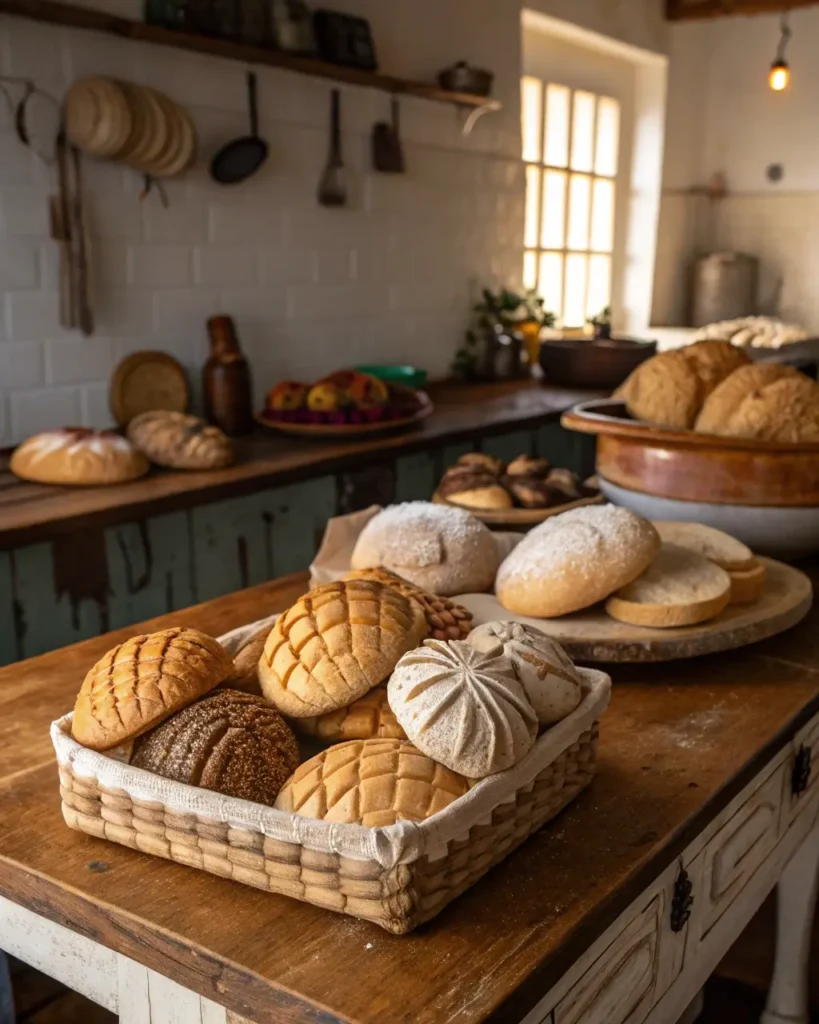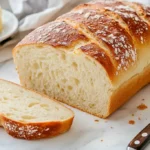Introduction to Mexican Bread Culture
The significance of bread in Mexican cuisine
In Mexican cuisine, bread plays a significant role in daily life and celebrations. It is not just a food item; it is a cultural symbol that ties together generations. From casual family meals to special occasions, Mexican bread serves as a staple in many households. The love for bread extends beyond meals, often accompanying a cup of Mexican hot chocolate or coffee in the morning. In many Mexican homes, bread is part of the daily routine, whether it’s pan dulce (sweet bread) or the popular bolillo (a type of roll).
Bread holds a place of honor in both rural and urban areas of Mexico. It is an essential part of breakfast, lunch, and dinner, making it an integral component of the country’s rich food culture. Furthermore, Mexican bread often signifies tradition, especially when it comes to cultural festivals and religious holidays. For instance, Pan de Muerto is a special bread prepared for Día de los Muertos, illustrating the link between bread and Mexico’s heritage.

The variety and diversity of Mexican baked goods
When discussing what is the most popular bread in Mexico, it’s essential to understand the wide variety of baked goods that define the country’s rich bread culture. Mexican bakeries offer an array of bread types, ranging from sweet pastries like conchas to savory options such as bolillos. These bread varieties are distinguished not only by their ingredients but also by their shapes, textures, and flavors. The panadería (bakery) serves as a cornerstone in Mexican communities, where a diverse range of breads can be found, each representing regional specialties and traditions.
Mexican breads come in all forms, from the iconic pan dulce, which is adored for its sugary toppings, to the more neutral bolillo, used in daily meals. Mexican bread isn’t just consumed by the wealthy or elite; it is part of every social class, and its accessibility and affordability make it a food enjoyed by many.
How Mexican bread reflects the country’s cultural heritage
What is the most popular bread in Mexico may vary depending on location, but there is a common thread across the country: Mexican bread reflects deep-rooted traditions. Whether it’s Pan de Muerto celebrated during Día de los Muertos or conchas found at almost every street corner bakery, bread tells the story of Mexican culture. Mexican bread, in all its diversity, is a testament to the fusion of indigenous ingredients and Spanish influences. The unique flavor combinations found in these breads mirror the vibrant culture and history of the country. The act of making bread has been passed down through generations, and the panaderos (bakers) continue to uphold these traditions, ensuring that Mexican bread remains a symbol of heritage.
“To better understand the unique taste of conchas, read more about what a concha tastes like in this post.”
Types of Traditional Mexican Bread
Conchas: The Sweet, Shell-Shaped Delight
When thinking about what is the most popular bread in Mexico, conchas immediately come to mind. These sweet, shell-shaped breads are among the most recognized and beloved types of Mexican bread. The concha is soft and slightly sweet, with a sugar topping that forms a unique shell-like pattern. They are typically enjoyed at breakfast or as a snack, often paired with a hot beverage. The topping comes in various flavors, such as vanilla, chocolate, and strawberry, adding a unique twist to each bite. For many Mexicans, the concha is a nostalgic bread, evoking memories of family gatherings and morning routines.
It’s easy to see why conchas are considered a cultural symbol of Mexican bread-making. Their iconic shape and sweet, buttery taste have made them an enduring favorite in Mexican bakeries.
Bolillos: The Versatile Mexican Bread Roll
Another common question when discussing what is the most popular bread in Mexico is the bolillo, a versatile roll that is essential in many households. A bolillo is a white bread roll with a soft interior and a slightly crispy crust. It is the foundation of many traditional Mexican dishes, including tortas (Mexican sandwiches) and is often served alongside soups and stews. The bolillo has a simple, neutral flavor, which makes it perfect for absorbing the juices and flavors of other foods. Its crispy exterior and soft interior make it an ideal choice for dipping in salsas or mopping up hearty sauces.
The bolillo is found everywhere in Mexico—from street vendors to bakeries, where it is a staple bread for any meal.
Pan de Muerto: A Special Bread for Día de los Muertos
In answering what is the most popular bread in Mexico during a specific time of year, we must include Pan de Muerto—bread made especially for Día de los Muertos (Day of the Dead). This bread is prepared with a special recipe that includes an infusion of orange blossom, giving it a distinct aroma and flavor. Shaped like a skull or bones, Pan de Muerto is not only a delicious treat but also a symbol of remembrance. It is believed to honor the spirits of deceased loved ones. Its rich, buttery taste is complemented by its soft, fluffy texture, making it a cherished part of the holiday.
During Día de los Muertos, families place Pan de Muerto on altars to offer to their ancestors, symbolizing the bond between the living and the dead.
Pan de Elote: A Corn-Based Favorite
Pan de Elote is a cornbread variant popular in various regions of Mexico. This bread is made using cornmeal, giving it a sweet, moist, and dense texture. Unlike traditional breads made from wheat flour, pan de elote is a celebration of Mexico’s indigenous ingredients. It often appears during the harvest season or as part of festive gatherings. Its slightly grainy texture is complemented by the sweetness of corn, making it a delightful dessert or snack. The bread can be served on its own or as a side dish to enhance the flavors of Mexican stews and meats.
If you’re curious about what is the most popular bread in Mexico for those looking for a distinct taste, Pan de Elote is an option that should not be overlooked.

Famous Mexican Breads You Need to Try
Pan dulce: A range of sweet Mexican breads
Pan dulce (sweet bread) encompasses a wide variety of Mexican baked goods. Each region of Mexico has its own variations, but they are all loved for their sugary, indulgent nature. Among the most popular varieties of pan dulce are cuernitos, merengues, and conchas. Pan dulce is often eaten during breakfast or as an afternoon snack. It is not uncommon to see a family gathering around the table, enjoying fresh pan dulce with a cup of Mexican hot chocolate or café de olla.
These sweet breads are made with different types of dough, fillings, and toppings, ranging from sweet syrup to crunchy sugar, creating a delicious array of flavors.
Tortillas: Mexico’s staple bread-like food
Though tortillas may not fit the classic definition of bread, they hold an essential place in Mexican food culture. Corn tortillas, made from masa (corn dough), are the backbone of many Mexican dishes, from tacos to enchiladas. The tortilla has been a staple food since pre-Columbian times and remains a prominent part of daily life in Mexico. While tortillas might not be considered a “bread” in the traditional sense, their role in Mexican cuisine makes them a type of bread-like food that is just as vital to the culture. Tortillas are used in almost every meal, serving as the base for countless dishes.
If you’re curious about what is the most popular bread in Mexico in terms of versatility, tortillas are a must-try.
Biscochos: Sweet Mexican cookies that resemble bread
Another lesser-known yet equally important bread in Mexican cuisine is biscochos, a type of sweet cookie that often resembles bread in texture. Biscochos are crispy, sugar-coated treats commonly enjoyed during the holidays or as a side with coffee. These treats come in many variations, with ingredients such as anise seeds or cinnamon, adding a layer of aromatic flavor. Although biscochos are technically cookies, their resemblance to traditional breads and their popularity in Mexican cuisine make them a noteworthy mention in this guide.
Rosca de Reyes: The King’s Cake for Epiphany
Another beloved bread in Mexico is Rosca de Reyes, a special cake-bread made for Día de Reyes (Epiphany). Shaped like a crown and adorned with colorful candied fruits, Rosca de Reyes is traditionally eaten on January 6th to celebrate the arrival of the Three Kings. The bread symbolizes unity and celebration, as families gather around to share the cake. A small figurine of the baby Jesus is hidden inside the bread, and tradition holds that the person who finds it must host the celebration the following year.
“For a deeper dive into the sweet, fluffy texture of conchas, explore what a concha tastes like in our article.”
The Role of Mexican Bakeries (Panaderías) in Bread Making
The history of Mexican bakeries and their influence on bread varieties
Mexican bakeries, or panaderías, have been integral to the development and evolution of Mexican bread. The baking tradition dates back centuries, with a blend of indigenous ingredients and Spanish influences shaping the varieties we know today. Many bakeries in Mexico have been passed down through generations, preserving traditional recipes that have remained largely unchanged for centuries. These bakeries are not only places to purchase bread but are often hubs of community life. Their influence extends beyond the products they create—they help maintain and share cultural heritage.
Popular bakeries in Mexico City and beyond
In cities such as Mexico City, Guadalajara, and Oaxaca, bakeries are not just places for buying bread but cultural landmarks. Some bakeries, like Panadería El Molino in Mexico City, are famous for their pan dulce and conchas. Others, such as Panadería Rosetta, are known for their high-end artisanal breads. No matter the type of bread, these bakeries play a key role in continuing the tradition of Mexican bread.
Visiting these bakeries offers an opportunity to taste a variety of fresh breads and learn about the techniques that make Mexican bread unique.
How Panaderos (Mexican bakers) shape the tradition
Panaderos are the artisans behind every loaf of bread produced in Mexico. Their skills are passed down from generation to generation, with techniques honed over time. These bakers use traditional methods, some of which go back to pre-Hispanic times. Whether it’s the kneading of dough by hand or the use of brick ovens, panaderos play an essential role in ensuring that the art of Mexican bread-making remains vibrant.

Why Mexican Bread is a Favorite Worldwide
Mexican bread’s cultural influence outside of Mexico
Mexican bread has made a significant impact worldwide, particularly in regions with large Mexican communities. Cities in the United States like Los Angeles, Chicago, and Houston have seen an increase in demand for traditional Mexican breads, including conchas and bolillos. The popularity of Mexican bread has led to the opening of bakeries dedicated exclusively to authentic Mexican baked goods. This global influence has also sparked a fascination with Mexican culture, as bread becomes a window into the culinary traditions of the country.
Global appreciation of conchas and bolillos
Among the most popular Mexican breads worldwide are conchas and bolillos. These breads are now beloved beyond Mexican borders, with conchas being particularly famous for their unique sugary topping and delightful texture. Bolillos, often used to make sandwiches, have also found a place in international cuisine. In fact, many non-Mexican chefs have incorporated Mexican bread into their menus, further solidifying its position in global culinary culture.
The sweet flavors and unique textures that make Mexican bread special
The allure of Mexican bread lies in its sweet and savory flavors, often enhanced by a variety of toppings and fillings. The crispy texture of bolillos, paired with the softness of conchas, creates an unforgettable experience. Additionally, breads like pan de elote offer a taste of Mexico’s agricultural roots, while pan de muerto carries a rich, symbolic meaning. The use of local ingredients, such as corn, chocolate, and sugar, ensures that every bite of Mexican bread is an experience of flavor and history.
“If you’re wondering what conchas taste like, check out this detailed guide on their flavor profile.”
FAQs
What is the most famous bread in Mexico?
The most famous bread in Mexico is conchas, a sweet bread characterized by its soft texture and a crunchy, sugary topping that resembles a shell. It is a staple in Mexican bakeries and is often enjoyed at breakfast or with a warm beverage. Conchas come in a variety of flavors and colors, making them a beloved treat across the country.
What is the best Mexican sweet bread?
The best Mexican sweet bread is subjective and depends on personal taste, but pan de muerto and conchas are two of the most popular choices. Pan de muerto, a sweet, orange-flavored bread traditionally made for Día de los Muertos, is cherished for its flavor and symbolic meaning. On the other hand, conchas are an everyday favorite, known for their unique sweetness and crunchy topping, making them a top contender for the title of best Mexican sweet bread.
What is similar to conchas?
A bread similar to conchas is pan dulce. While conchas are the most famous type of pan dulce, the category also includes a wide variety of sweet breads, like cuernitos (a crescent-shaped bread) and empañadas (sweet pastries filled with fruit or cream). Like conchas, these breads are sweet, soft, and enjoyed as a morning treat or dessert. The main difference is often the shape and filling, but all share a similar dough base.
What do Mexicans call bread?
In Mexico, bread is referred to as pan. This term encompasses all types of bread, from everyday loaves to sweet treats like pan dulce. The variety of Mexican bread is vast, and it plays a central role in the country’s culinary culture, with different regions offering their own unique versions.
Conclusion
In conclusion, the variety of Mexican bread is vast, with each region offering its own specialty. From the sweet, shell-shaped conchas to the versatile bolillos, Mexican bread is a central part of daily life and cultural celebrations. Exploring these breads offers a deeper understanding of Mexico’s culinary history and traditions. Whether you’re trying pan dulce for the first time or savoring a warm bolillo with your meal, Mexican bread is a must-try for anyone looking to experience the flavors of Mexico. Don’t miss the chance to visit a panadería and discover the world of authentic Mexican breads.









